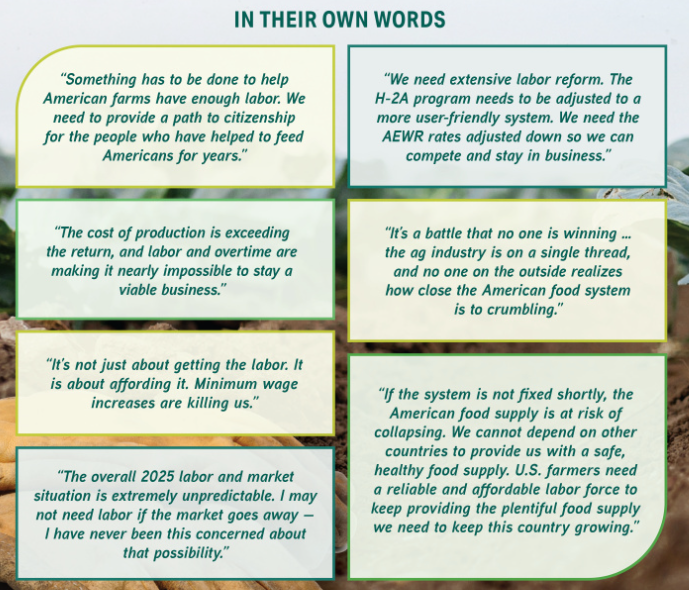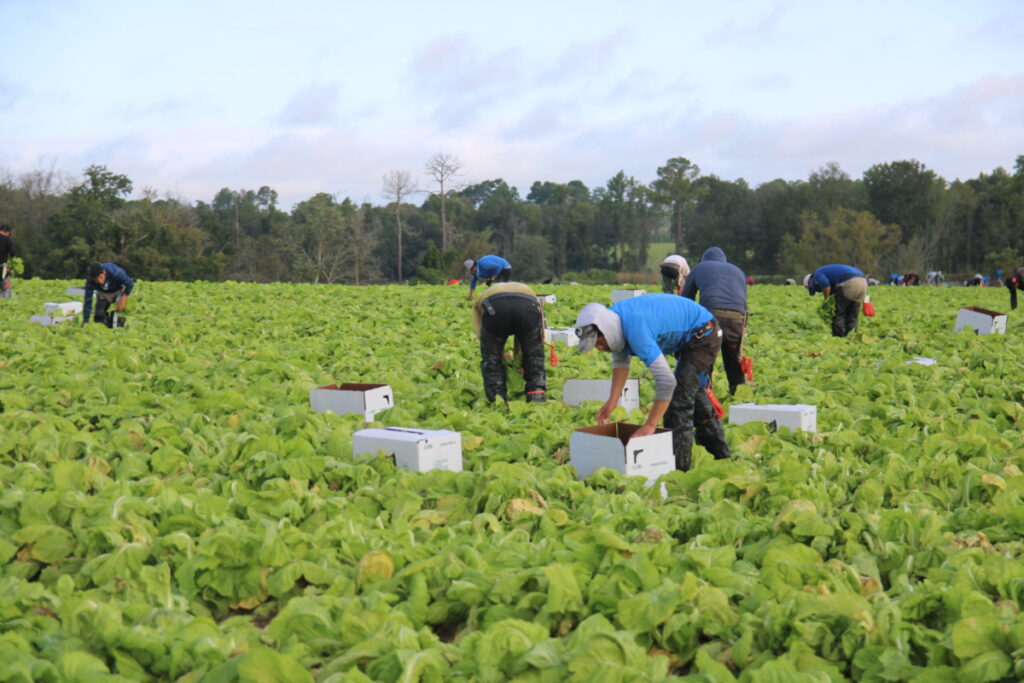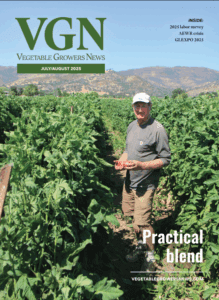
Jul 25, 20252025 Ag Labor Survey shows grower worries over AEWR, labor rules
Frustration over how fruit and vegetable growers can afford to pay people to harvest their crops is growing in the nation’s fields, orchards and vineyards.
As H-2A becomes more difficult to use by the year, growers find escalating increases in Adverse Effect Wage Rates (AEWR) and associated costs not only challenging but also threats to their farms’ existence.
The labor headaches have forced specialty crops growers to reduce acreage, with some growers even considering leaving the business.
In the 2025 Specialty Ag Labor Survey conducted by Great American Media Services (GAMS), 70% of growers reported securing adequate labor — a notable increase from 54% reported in our 2024 survey. Despite this positive trend, growers continue to face serious challenges related to labor availability and sustainability.
“We very likely will not be profitable this season,” one grower wrote. “We are hopeful the (H-2A) program gets overhauled for the future. If it does not, then we will cut unprofitable crops from our plan. If it continues at the current pace of increase, we will likely sell our farm to developers and retire.”

The AEWR headaches prompted one grower to state they plan to sell their farm, while another stated they are “getting out of farming” and will try to sell their property.
“The (AEWR) rates went down a few pennies this year, but even with that, we, as a small farm, are considering retiring early,” another grower said.
Labor shortages caused up to a third of crops to go unharvested in 2024. A little more than a third recorded losing 10% to 20% of their crops, with others claiming smaller losses.
“We did not make a profit in 2022, and we are unlikely to in 2025,” another grower said. “The ever-rising increases have pushed labor to nearly 50% of our overall expenses. But we must use H-2A workers (who are wonderful) to meet our labor needs. The domestic seasonal workforce is dwindling.”
H-2A role
The H-2A program remains important for many growers. In 2025, nearly half (48%) of respondents were using H-2A labor, similar to last year’s survey.
The number of growers outsourcing the H-2A recruiting process was 33%, down from 49% the previous year. When queried if they would consider fully outsourcing the H-2A process and labor management, 46% answered affirmatively, lower than 57% last year.

Because its operation requires much hand labor, the H-2A program has allowed one grower to remain in business. While the costs associated with housing and visas have been manageable, the AEWR wage increases are not practical.
“We feel as if we are slowly being pushed out of existence with each new increase,” the grower wrote. “We also have had no one locally apply for the work that we offer in three years. How can we help voice this to the people who make the decisions?”
When growers were asked if they plan to use the H-2A program less or if they are considering discontinuing its use due to the new wage requirements, nearly a fourth (23%) answered yes, with 38% no. About 40% said they don’t use H-2A.
“We are avoiding H-2A because of cost,” one grower said.
In describing the H-2A legal process and associated regulations, half of growers characterized them as “very challenging” with a third calling the process “somewhat challenging.”
The hard numbers were detailed by one grower: “I have gross revenue of $200,000. H-2A is $110,000. $90,000 is left for chemicals, fertilizer and two hired men besides equipment costs. I am in an unsustainable situation.”
Cost headaches
“Costly fees and increasing wages and housing costs are impacting the bottom line,” a grower disclosed. “Hiring local help requires the same H-2A wage, but they are less reliable. Less profitable and more labor-intensive crops will need to be stopped.”
Labor costs compelled some growers to alter their marketing.
“It has caused us to have to decrease our operations and go to a direct market instead of all wholesale production,” a grower said. “It has put a significant strain on our family operation.”

From the West Coast to the East Coast, growers find rising AEWR rates challenging.
“Washington and King County has the most expensive minimum wage in the USA, so we will struggle to remain competitive,” a Washington grower commented. “We are being taxed and regulated out of existence.”
California’s labor costs “continue going up significantly for all labor. Reducing labor where we can has been critical,” a grower relayed.
New York’s minimum wage and overtime rules affect labor costs as much as the H-2A wage minimum, a grower said.
“We do not have a shortage issue. It’s a cost issue,” a grower said, while another said “there is no shortage, just skyrocketing costs.”
Those costs echoed in growers’ desperation.
“We need help!,” one grower pleaded.
“Producers have always been up to the challenges that consumers, Mother Nature, markets and trade have dealt them, but this labor issue might just be the ‘straw that breaks the camels back’, at least for small and medium producers,” another commented. “I pray that we are able to storm this issue as we have weathered others in the past.”
Grower adjustments
To counter the rising costs and difficult regulations, 40% of growers said they plan to grow fewer crops, 38% each intend to hire interns and harvest the crops themselves, while 28% plan to adopt automation.
“We are not harvesting low-profit apples and vegetables,” a grower wrote.

A Michigan grower recommended increasing Extension partnerships.
“Collaborate with Michigan State University to develop harvesting robots,” the grower advised.
“H-2A should allow cross-state labor sharing to alleviate peak seasonal demands.”
One grower suggested growers partner with community colleges. “Develop in-house training programs,” another grower proposed.
The types of automation growers are considering to combat labor shortages include harvesting (63%), spraying (37%), grading (35%), weeding (33%), fertilizing, water/irrigation management, planting, seeding and cleaning.
“We either need to automate or stop growing high-labor crops,” a grower said.
Pruning, thinning and harvest costs increased for many growers.
“We had to quit the labor-intensive crops,” a grower disclosed. “We couldn’t afford the ever- increasing wages.”
The survey saw the largest responses from growers in California and Michigan, New York, Pennsylvania, Washington, Florida, Illinois, Wisconsin, North Carolina, New Jersey, Massachusetts, Ohio and Minnesota with smaller responses from growers in Arizona, Oregon, South Dakota, Indiana, South Carolina, Connecticut and Maine.
By Doug Ohlemeier, Assistant Editor
















